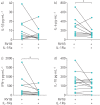Cytokine responses to two common respiratory pathogens in children are dependent on interleukin-1β
- PMID: 29204435
- PMCID: PMC5703357
- DOI: 10.1183/23120541.00025-2017
Cytokine responses to two common respiratory pathogens in children are dependent on interleukin-1β
Abstract
Protracted bacterial bronchitis (PBB) in young children is a common cause of prolonged wet cough and may be a precursor to bronchiectasis in some children. Although PBB and bronchiectasis are both characterised by neutrophilic airway inflammation and a prominent interleukin (IL)-1β signature, the contribution of the IL-1β pathway to host defence is not clear. This study aimed to compare systemic immune responses against common pathogens in children with PBB, bronchiectasis and control children and to determine the importance of the IL-1β pathway. Non-typeable Haemophilus influenzae (NTHi) stimulation of peripheral blood mononuclear cells (PBMCs) from control subjects (n=20), those with recurrent PBB (n=20) and bronchiectasis (n=20) induced high concentrations of IL-1β, IL-6, interferon (IFN)-γ and IL-10. Blocking with an IL-1 receptor antagonist (IL-1Ra) modified the cellular response to pathogens, inhibiting cytokine synthesis by NTHi-stimulated PBMCs and rhinovirus-stimulated PBMCs (in a separate PBB cohort). Inhibition of IFN-γ production by IL-1Ra was observed across multiple cell types, including CD3+ T cells and CD56+ NK cells. Our findings highlight the extent to which IL-1β regulates the cellular immune response against two common respiratory pathogens. While blocking the IL-1β pathway has the potential to reduce inflammation, this may come at the cost of protective immunity against NTHi and rhinovirus.
Conflict of interest statement
Conflict of interest: Disclosures can be found alongside this article at openres.ersjournals.com
Figures






Similar articles
-
Multiple inflammasomes may regulate the interleukin-1-driven inflammation in protracted bacterial bronchitis.ERJ Open Res. 2018 Mar 23;4(1):00130-2017. doi: 10.1183/23120541.00130-2017. eCollection 2018 Jan. ERJ Open Res. 2018. PMID: 29594175 Free PMC article.
-
Airway cells from protracted bacterial bronchitis and bronchiectasis share similar gene expression profiles.Pediatr Pulmonol. 2018 May;53(5):575-582. doi: 10.1002/ppul.23984. Epub 2018 Mar 24. Pediatr Pulmonol. 2018. PMID: 29575797
-
Is Alveolar Macrophage Phagocytic Dysfunction in Children With Protracted Bacterial Bronchitis a Forerunner to Bronchiectasis?Chest. 2016 Feb;149(2):508-515. doi: 10.1016/j.chest.2015.10.066. Chest. 2016. PMID: 26867834
-
Protracted bacterial bronchitis: The last decade and the road ahead.Pediatr Pulmonol. 2016 Mar;51(3):225-42. doi: 10.1002/ppul.23351. Epub 2015 Dec 4. Pediatr Pulmonol. 2016. PMID: 26636654 Free PMC article. Review.
-
When the Cough Does Not Improve: A Review on Protracted Bacterial Bronchitis in Children.Front Pediatr. 2020 Aug 7;8:433. doi: 10.3389/fped.2020.00433. eCollection 2020. Front Pediatr. 2020. PMID: 32850546 Free PMC article. Review.
Cited by
-
Extracellular Vesicles Cargo in Modulating Microglia Functional Responses.Biology (Basel). 2022 Sep 29;11(10):1426. doi: 10.3390/biology11101426. Biology (Basel). 2022. PMID: 36290330 Free PMC article.
-
Lipopolysaccharide Administration Alters Extracellular Vesicles in Cell Lines and Mice.Curr Microbiol. 2021 Mar;78(3):920-931. doi: 10.1007/s00284-021-02348-5. Epub 2021 Feb 9. Curr Microbiol. 2021. PMID: 33559732 Free PMC article.
-
Effects of Pseudomonas aeruginosa on Microglial-Derived Extracellular Vesicle Biogenesis and Composition.Pathogens. 2019 Dec 14;8(4):297. doi: 10.3390/pathogens8040297. Pathogens. 2019. PMID: 31847332 Free PMC article.
-
Multiple inflammasomes may regulate the interleukin-1-driven inflammation in protracted bacterial bronchitis.ERJ Open Res. 2018 Mar 23;4(1):00130-2017. doi: 10.1183/23120541.00130-2017. eCollection 2018 Jan. ERJ Open Res. 2018. PMID: 29594175 Free PMC article.
References
-
- Wurzel DF, Marchant JM, Yerkovich ST, et al. Protracted bacterial bronchitis in children: natural history and risk factors for bronchiectasis. Chest 2016; 150: 1101–1108. - PubMed
-
- McShane PJ, Naureckas ET, Tino G, et al. Non-cystic fibrosis bronchiectasis. Am J Respir Crit Care Med 2013; 188: 647–656. - PubMed
-
- Chang AB, Redding GJ, Everard ML. Chronic wet cough: protracted bronchitis, chronic suppurative lung disease and bronchiectasis. Pediatr Pulmonol 2008; 43: 519–531. - PubMed
-
- Marchant JM, Masters IB, Taylor SM, et al. Evaluation and outcome of young children with chronic cough. Chest 2006; 129: 1132–1141. - PubMed
LinkOut - more resources
Full Text Sources
Other Literature Sources
Research Materials
